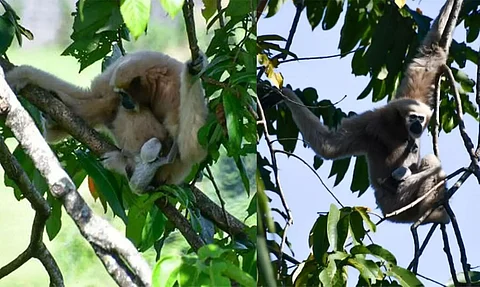
- Home
- Live Blog
- Breaking News
- Top Headlines
- Cities
- NE News
- Sentinel Media
- Sports
- Education
- Jobs

Itanagar: Itanagar Biological Park, popularly known as the Itanagar Zoo, has created another milestone with two Eastern Hoolock Gibbons (Hoolock leuconedys) born there within eight days, increasing the number of Hoolok Gibbons population to 19 and making the animal lovers of Arunachal Pradesh very happy.
The first baby Hoolock was born to the zoo's youngest couple 'Jesu' and 'Sonu' on December 12 and the second to 'Bhat' and 'Yapa' on December 20, the biological park's veterinarian Dr Sorang Tadap looks after the health of the animals.
There was another baby born in the month of September named 'Gandhi'.
"The genders of the new-born gibbons can be identified only after four years through morphological changes in their skin colour," Dr Tadap said. The babies were kept under 15-day observation, which is a very crucial period for their survival.
The zoo, covering an area of over 250 hectares, had launched the Hoolock Gibbon Conservation Breeding Programme in 2007. Seventeen gibbons have been born in the facility since 2008, of which only three have died.
The zoo also happens to be the first lesser apes' conservation-cum-breeding centre in the country fully funded by The Central Zoo Authority (CZA) of India.
Itanagar Zoo had earned the distinction after a female gibbon was brought from Roing in Lower Dibang Valley district in 2008 and named it 'Mishmi Baido' (Mishmi sister). It had given birth to a baby gibbon in the year 2015. Its partner was named 'Corneal Opacity' because it had a defected eye, according to the curator of the park, Raya Flago.
Hoolock Gibbon is the only primate species in the country and the state animal of Arunachal Pradesh, where its population is around 1500 making it one of the highly endangered species.
"It is our prime duty to save this beautiful animal from extinction," said Flago.
The species also happens to be the second-largest of the gibbons, after the Siamang having a reach of 60 to 90 cm and weighs six to nine kg. The sexes are about the name size, however, they differ considerably in its colouration: males are black with remarkable brows while females have grey-brown fur, darker at the chest and neck with white rings around the eyes and mouths which give them a mask-like appearance.